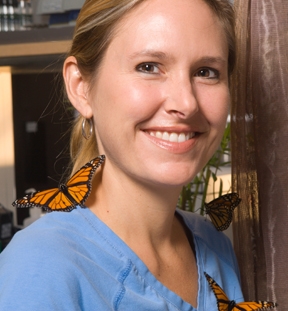
However, in wild populations, monarchs are commonly infected "with a specialist protozoan Ophryocystis elektroscirrha; this parasite can be transmitted both vertically and horizontally and causes debilitating infections."
Altizer, an associate professor in the Odum School of Ecology, University of Georgia, Athens, will discuss "Migratory Immunity: Parasite Infection, Host Defense and Fitness Costs in Monarch Butterflies" at the UC Davis Department of Entomology seminar on Wednesday, May 9 in 122 Briggs Hall.
It promises to be well-attended, given the avid interest in monarchs and Altizer's expertise.
What's so special about monarchs?
"Monarch butterflies are known for the incredible mass migration that brings millions of them to California and Mexico each winter," according to an article in National Geographic. "North American monarchs are the only butterflies that make such a massive journey—up to 3,000 miles (4,828 kilometers). The insects must begin this journey each fall ahead of cold weather, which will kill them if they tarry too long."
The National Geographic article points out that "Only monarchs born in late summer or early fall make the migration, and they make only one round trip. By the time next year's winter migration begins, several summer generations will have lived and died and it will be last year's migrators' great grandchildren that make the trip. Yet somehow these new generations know the way, and follow the same routes their ancestors took—sometimes even returning to the same tree."
Altizer's research focuses on the interplay between animal behavior and the spread and evolution of infectious diseases. For the past 15 years, she has studied monarch butterfly migration, ecology, and interactions with a protozoan parasite, asking how seasonal migration of these butterflies affects parasite transmission.
She also researches a number of other projects, including mammalian infectious diseases and songbird-pathogen dynamics, including studies of house finch conjunctivitis, West Nile virus, and salmonellosis.
But we butterfly enthusiasts are happy she's studying the monarchs!
Attached Images:
